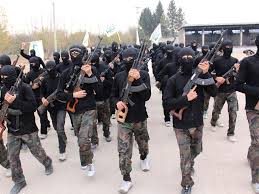Beirut- In the beginning of December, some of Harakat Ahrar al-Sham leaders in Syria announced the formation of a new faction in the movement called Jaish al-Ahrar led by Jaber al-Sheikh. The group asserted that the faction will work under the directions of the movement; yet, according to the El-Dorar Al-Shamia, the movement’s leader Ali al-Omar denied and denounced this step.
This division emphasizes interior conflicts in the biggest extremist organization in Syria, which may have its impact on the opposition’s future starting from the big losses it faced with Aleppo’s fall in the hands of the regime and its Iranian and Russian allies.
Prior to the leadership’s elections in November, the extremist wing in Ahrar al-Sham nominated Abu Jaber al-Sheikh for a second term, while the pragmatic movement’s members preferred to back Kinan Nahas brother of Labib Nahas, the chief of foreign political relations in the organization. When the extremists recognized they couldn’t achieve an interior support to win support of third the Shura Council, they suspended their membership in it.
El-Dorar Al-Shamia website reported that 12 sheikhs and heralds from the movement called members of Jaish al-Ahrar to reconsider their decision and accused them of dividing the group. They also called all the leaders and factions of opposition to join forces and forget their conflicts for the sake of the oppressed Syrian people.
Collective leadership
Aron Lund, fellow in the Carnegie Middle East Program said that unlike other rebel groups in Syria, Harakat Ahrar al-Sham has always focused on maintaining the mass leadership through the Shura Council and other similar institutions. This approach, which according to the analyst, directly suspended the leadership of Hashem al-Sheikh, who succeeded Hassan Abboud who was assassinated in September 2014. Lund sees that Harakat Ahrar al-Sham’s success in overcoming the disaster of September 2014 was due to the generous funds the movement received from Turkey and a Gulf state along with the keenness of the organization on facing its loss by upholding collective leadership and controlling the local factions.
Relationship with Fath al-Sham
However, Lund notes that this successful strategy has enhanced the institutionalization of ideologies in the group and remarkably weakened the leadership. He also sees that countries supporting it have changed their positions and the conflict among members on joining Fath al-Sham’s organization played a significant role in the separation.
The analyst adds that the separation’s aftermath has appeared one year ago and that the current leader of the movement sought to enhance the role of the political council and to boost the other powers of the revolution. However, the conservative movement accused him of compromising the Haraka’s principles and its intellectual structure.
Conflict among different blocks
Many other reasons stand behind the rise of conflicts in Harat Ahrar al-Sham, as according to sources, this division likely resulted from the reorganization of the pragmatic wing based on the political shifts in Turkey. Over the past months, a Russian-Turkish agreement led to launch the Ankara-backed Euphrates Shield operation to which joined some groups from the Syrian opposition to combat ISIS and Kurdish militias instead of targeting Assad’s regime.
Number of fighters
Jaish al-Sham bragged about its troops in Aleppo, Idlib and Hama, which include around 5000 members. However, other sources said it actually included 1000 members with some of them recruited from small groups led by some of Ahrar al-Sham’s ex-founders.
Survival challenges
The timing of the emerging separation and the establishment of Jaish al-Ahrar has been so critical. And in spite that the organization has overcome many crucial phases, today it is facing threats more than any time ever before. These threats will not only weaken the organization which represents the biggest military faction in the Syrian opposition, but will also affect all the opposition and revolution’s powers, which face the most dangerous phase ever.
According to Lund, Fath al-Sham Front will likely be the biggest beneficiary of these divisions as many members from Ahrar al-Sham will prefer to join it. Eventually, the separation decision announced by Jaish al-Ahrar is still considered a bad development for the Syrian revolution; with the control of Assad’s forces over Aleppo, and its swift advancement near Damascus, attempts to settle interior problems among competing parties will be costly.
